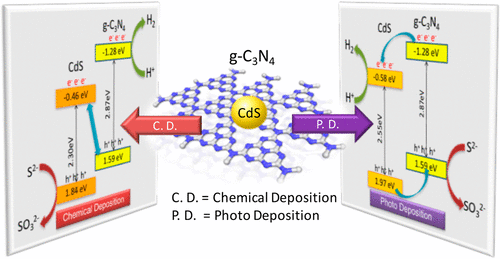当前位置:
X-MOL 学术
›
ACS Catal.
›
论文详情
Our official English website, www.x-mol.net, welcomes your
feedback! (Note: you will need to create a separate account there.)
Consciously Constructing Heterojunction or Direct Z-Scheme Photocatalysts by Regulating Electron Flow Direction
ACS Catalysis ( IF 11.3 ) Pub Date : 2018-02-08 00:00:00 , DOI: 10.1021/acscatal.7b04323 Wenshuai Jiang 1 , Xupeng Zong 2, 3 , Li An 1 , Shixin Hua 1 , Xiang Miao 2, 3 , Shiliang Luan 1 , Yuanjing Wen 1 , Franklin Feng Tao 4 , Zaicheng Sun 1
ACS Catalysis ( IF 11.3 ) Pub Date : 2018-02-08 00:00:00 , DOI: 10.1021/acscatal.7b04323 Wenshuai Jiang 1 , Xupeng Zong 2, 3 , Li An 1 , Shixin Hua 1 , Xiang Miao 2, 3 , Shiliang Luan 1 , Yuanjing Wen 1 , Franklin Feng Tao 4 , Zaicheng Sun 1
Affiliation

|
Heterojunction and direct Z-scheme nanostructures are two typical representatives of an efficient photocatalyst, which is composed of two semiconductors. However, it is a great challenge to construct each of them on purpose. The photodeposition technique can be a potentially powerful tool to regulate the electron flow direction for constructing these nanostructures. In this report, CdS nanoparticles were deposited on the g-C3N4 nanosheets by photodeposition and chemical deposition methods for comparison. In the photodeposition case, PL and charge flow tracking demonstrate that a type II heterojunction is constructed because CdS is selectively deposited at the electron transfer site of g-C3N4, which leads to the photoexcited electron from g–C3N4 tending to transfer to CdS in the composites. In the latter, the CdS is randomly deposited onto the g-C3N4 nanosheets through chemical deposition. There is no preferred site for deposition or charge transfer in the composite. The results illustrate that the electron of CdS tends to recombine with the hole from g-C3N4. The direct Z-scheme is predominant for the CdS/g-C3N4 prepared by the chemical deposition route. Furthermore, the photocatalytic performance and stability also confirm the above results. On the of these, we can deduce that the photodeposition method can be used to regulating the electron transfer route. We expect this report to shed light on the rational design of heterojunction or direct Z-scheme type composites.
中文翻译:

通过调节电子流向自觉构建异质结或Z型直接光催化剂
异质结和直接Z方案纳米结构是由两种半导体组成的高效光催化剂的两个典型代表。但是,有目的地构建它们中的每一个都是巨大的挑战。光沉积技术可能是潜在有力的工具,可以调节电子流向以构建这些纳米结构。在此报告中,通过光沉积和化学沉积方法将CdS纳米颗粒沉积在gC 3 N 4纳米片上进行比较。在光沉积情况下,PL和电荷流跟踪表明构造了II型异质结,因为CdS选择性沉积在gC 3 N 4的电子转移位点,导致来自g – C 3 N 4的光激发电子趋于转移到复合材料中的CdS中。在后者中,CdS通过化学沉积随机沉积到gC 3 N 4纳米片上。在复合物中没有沉积或电荷转移的优选位置。结果表明,CdS的电子易于与gC 3 N 4中的空穴复合。直接Z方案主要用于CdS / gC 3 N 4通过化学沉积路线制备。此外,光催化性能和稳定性也证实了上述结果。基于这些,我们可以推断出光沉积方法可用于调节电子转移路径。我们希望该报告能阐明异质结或直接Z方案类型复合材料的合理设计。
更新日期:2018-02-08
中文翻译:

通过调节电子流向自觉构建异质结或Z型直接光催化剂
异质结和直接Z方案纳米结构是由两种半导体组成的高效光催化剂的两个典型代表。但是,有目的地构建它们中的每一个都是巨大的挑战。光沉积技术可能是潜在有力的工具,可以调节电子流向以构建这些纳米结构。在此报告中,通过光沉积和化学沉积方法将CdS纳米颗粒沉积在gC 3 N 4纳米片上进行比较。在光沉积情况下,PL和电荷流跟踪表明构造了II型异质结,因为CdS选择性沉积在gC 3 N 4的电子转移位点,导致来自g – C 3 N 4的光激发电子趋于转移到复合材料中的CdS中。在后者中,CdS通过化学沉积随机沉积到gC 3 N 4纳米片上。在复合物中没有沉积或电荷转移的优选位置。结果表明,CdS的电子易于与gC 3 N 4中的空穴复合。直接Z方案主要用于CdS / gC 3 N 4通过化学沉积路线制备。此外,光催化性能和稳定性也证实了上述结果。基于这些,我们可以推断出光沉积方法可用于调节电子转移路径。我们希望该报告能阐明异质结或直接Z方案类型复合材料的合理设计。


















































 京公网安备 11010802027423号
京公网安备 11010802027423号